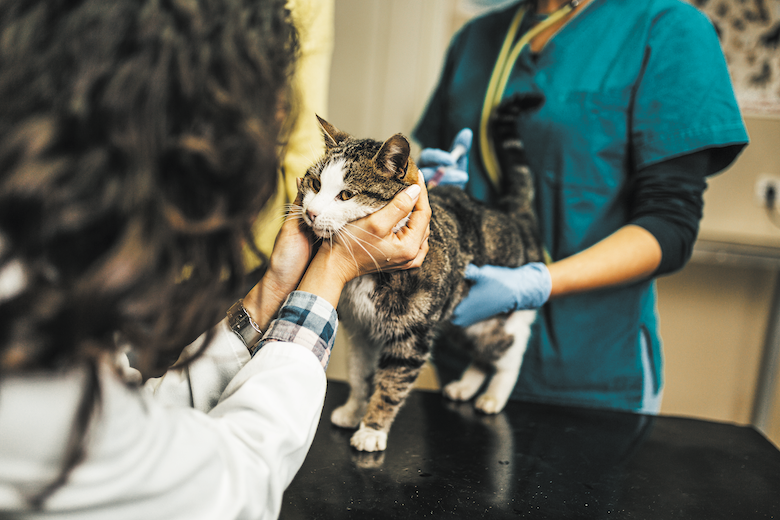Louise Holton may not be a name on the lips of cat lovers everywhere, but it should be. In 1975, Holton worked with the Johannesburg SPCA in South Africa on trap-neuter-return for community cats. She worked with veterinarian and TNR pioneer Jenny Remfry; world-famous author and biologist Roger Tabor; and cat rescue organizations in the U.K., bringing the knowledge she gained to the United States to set up TNR programs here.
Related: Why Getting Involved in TNR is Easier Than You Think
Louise co-founded Alley Cat Allies in 1990, and in 1997 she started Alley Cat Rescue with a trap-neuter-return program for feral cats and an adoption program for friendly cats. Today, ACR’s programs include a low-cost spay/neuter clinic, Cat Action Teams and TNR programs for community cats.
“We work on international TNR programs, mainly through offering support, and we do hands-on TNR in Los Angeles; Roanoke, Virginia; and Maryland,” Louise says. “We fund and run spay clinics in each place.”
Helping community cats
Alley Cat Rescue has spayed and neutered more than 180,000 cats since its inception. The organization currently spays and neuters well over 3,500 cats per year and is working to increase those numbers.
One thing that makes Alley Cat Rescue unique is its Cat Action Teams. “We have Cat Action Teams in every state,” Louise says. “These are groups who can help people find low-cost vets, perhaps lend them traps and guide them through the process of TNR.”
ACR also has a directory of low-cost spay/neuter clinics listed on its website to help potential colony managers find clinics to help them. Like many community cat organizations, Alley Cat Rescue partners with local advocates, city and regional government, and individuals who want to help.
Alley Cat Rescue’s Spring Spay Challenge, for example, has developed a national network of veterinarians offering free or low-cost spay/neuter services for TNR. “More than 1,400 veterinarians in 45 U.S. states have participated in our Spring Spay Challenge campaign, along with veterinarians in Canada, Croatia, Greece, Japan, Israel, India and South Africa,” Louise says. “Through this program, we strive to bridge the gap between rescue groups, veterinarians and cat caretakers.”
And it has worked. As a result of the Spring Spay Challenge, 80,000 community cats have been sterilized.
Another ACR accomplishment Louise is particularly proud of is Alley Cat Rescue’s Guide to Managing Community Cats, a comprehensive guide to TNR, feral cats, colony care, advocacy for feral cats and more. The guide is available free for download on ACR’s website.

Changing attitudes
Alley Cat Rescue has been changing hearts and minds about TNR for decades. Maryland, for example, was initially opposed to TNR for feral cats, but over time, the organization’s efforts have paid off, and TNR is now an accepted method of cat colony management in that state. Why? The results are there, and they’re backed up by data.
The spay/neuter program in Maryland has effectively reduced the intake of feral cats in the targeted regions by 18% and reduced euthanasia rates by 38%. In 2018, Alley Cat Rescue received funding of almost $29,000, which allowed the organization to spay and neuter 752 cats in ACR’s targeted regions in that state. ACR has also been advocating in California.
In 2005, a court injunction forced the City of Los Angeles to stop supporting trap-neuter-return activities based on their potential environmental impact. The city completed an environmental impact report that marked off Environmentally Sensitive Areas (ESAs), then proposed a way to begin TNR efforts again. However, it turned out that the proposal made it all but impossible to legally TNR community cats. The city proposed a feral cat feeding ban in all areas considered ESAs, plus a one-mile buffer zone around those areas. In those areas — which comprise a huge portion of the city — feeding would only be allowed as bait in traps, limited to 30 minutes, could only occur during limited daytime hours and would need to be monitored at all times.
“We have been working closely in Los Angeles with authorities and various groups to get the ban on TNR there overturned,” Louise says.
Alley Cat Rescue was one of many organizations that stepped up to advocate for the removal of ESAs from the TNR proposal or, if those zones needed to be kept for legal or political reasons, to amend the language to allow for effective TNR and colony management programs in and near ESAs.
For 23 years, Alley Cat Rescue has been working on the ground and in the halls of government to improve the lives of community cats.
Top photograph: VII-photo | Getty Images
To learn more visit saveacat.org or Facebook.com/alleycatrescueinc.
